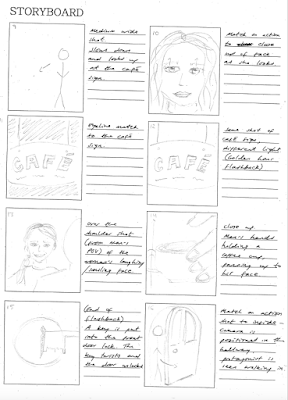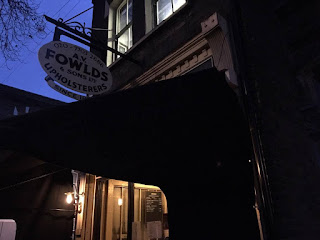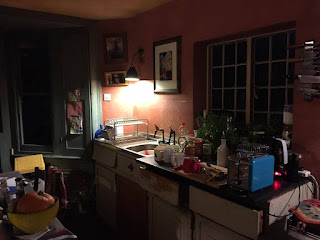I was very fortunate that Meg and I get on really well and we
both had a very similar vision for the film: the style, the tone, the look, the
shots. We realised that we were going to have to thoroughly plan everything as
much as we could, and our research and planning we had already done before
working together, and our interest in other specific films really helped us to
construct the look we wanted for the film.
The style and narrative
It was really important to both of us that we made a film
that had a quite complex plot, had a social realist tone, and that it looked
like a real film. We went through extensive planning, looking at specific
examples from our favourite films, particularly those of the social realist and
thriller genre, of location, style, plot, characters, semiotics and colour
palettes that we could emulate in our own work. We looked at casting
meticulously, working with our friends who we knew were reliable, could work
with our schedule and could appear to be the right age (Tom older than Sonia).
We cast our friend Sonia as the protagonist, and though she was different to
our original character profile (as Sonia is black and we had originally planned
to cast someone who was white), but we actually preferred this as we thought it
would be important to portray different social groups and have an interracial
relationship. Looking back through our evaluation questions, Meg and I have
realised how layered the narrative really is and how detailed our purposes for
each shot were. There are multiple different readings that could come from this
opening (which you can read about in evaluation question 2 in greater detail),
and though we know how the rest of the film would have developed through
negotiated readings, it was really interesting to see through feedback from
surveys and friends what they thought really happened, and what would happen
next.
Shotlist
As we thought in such similar ways we were already visualising
the same sort of shots we would use for the opening, and our narrative helped
to shape this too: close up match-on-action shots on the phone and the knife;
shot reverse shots in the coffee shop; establishing wide shot across the road
at the bus stop; and low-angle shots looking up to the coffee shops sign, but
at different times of day. Developing
from the preliminary task, we knew the importance of having a groundwork of
shot reverse shots, using the 180 degree rule, and match on action shots, but
to also build upon these basics. Unlike the prelim, we planned an extensive
shot list, and Meg drew up a story board. We also, however, gave ourselves
leeway to work around the locations we were working in, and leeway to experiment
on location with different shots.


Location
From doing the prelim task we knew the importance of finding
appropriate locations to suit the narrative and the style of the film. We were
very lucky that our friend lived in an area which would work really well for
our film: it could look like a rough and busy area on the main road, but the
side road on which he lived would juxtapose as it is much quieter. It also
worked well as he lived right next door to a coffee shop, which we had to ask
the owner’s permission to film in, and fitted perfectly with the narrative.
Having everything in one place also helped because we didn’t have to shoot in
multiple different locations on different sides of London. We also just loved
his house: it had everything we needed there, we didn’t have to bring anything
else with us- it already looked like a film set! At school we also used the
darkroom to film the second flashback as it would mean we got to shoot in a
room with red lighting – an aspect that was very important to us since the
start of the process- and we didn’t have to edit in the red in post-production.




On the day
We planned to film separate scenes on separate days, but
fortunately the filming process didn’t take very long as everything was in such
close proximity. We spent one evening filming all of the shots in the house,
and some shots on the main road. It was a great surprise on the day as by using
a specific lens on my camera, the lights in the background of each shot blurred.
Using this to our full advantage, we experimented with many different shots to
make the best use out of it which created a really beautiful effect, and we
think added a lot to the film. The golden hour flashback was very important to
film at a specific time of day, about 4 o’clock, so we had a very limited
amount of time to get everything we wanted before it got dark (about 5 o’clock
in winter). We were also pressed for time as the coffee shop closed at about
4:45, so we had to work very quickly. On that day we then waited for it to get
dark do we could film extra shots and diegetic sound on the main road that we
didn’t get on the other day of filming. We filmed the second flashback in the
darkroom on a separate day.
Technical development
I have progressed a lot from when we first started the course,
which I think you can clearly see when comparing the prelim to our final film.
In particular I have learnt how to use sound equipment correctly, and how to
edit this successfully along with a soundtrack that reflects the mood of the
film. As you can see in our evaluation question 6, we learnt more about the
benefits and problems with using a Conon 550D and f1.4 lens- the shots were really
beautiful with a very precise point of focus, but the manual focus was very difficult
to use, particularly during walking shots. I think we actually got around this
very well, and managed to edit the most successful shots to create a really
beautiful opening. My editing skills greatly improved, and I think that in
particular through post-production our soundtrack was really strong, and our transitions
between the present and the past were very clear.
Teamwork
Meg and I tried to split the responsibilities evenly with
each other: Meg did most of the filming while I did all of the sound, and we
played to our strengths, so as Meg is really arty she made the storyboard and
complied the shotlist, while I did more work in post-production through
editing, and putting the soundtrack together. We also shared the evaluation
tasks. It was great to work with Meg as we had such similar views and we knew
exactly what we wanted for the film, and she and I cared so much about wanting
to bring all our hard work to fruition. I think the result was really
successful, and it turned out even better than we wanted it to.








